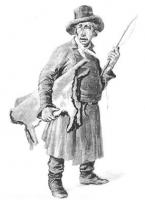0



This is what Lithuanian scientists found out about anthropological differnces between Lithuanian regions in 1952-1955
Inhabitants of majority of Lithuanian territory (Samogitia, Western Šilutė, Suvalkija, Western Aukštaitija) have taller than the average height, theyir hair are greysih or chestnut, slightly wavy. Eyes usually light blue, greenish, grey.
The skull (occiput) is wide, round, brachycephalic , forehead is steep, narrow face, long nose which is straight or with a bump and strongly protruding.
Such people live in poland, Chechia, South-Eastern Germany. This anthropoligical type based on this gepgraphical distribution is called Central European type.
The look of Eastern Lithuanians (Dzūkija and Eastern Aukštaitija) is a bit different: the height is shorter, hair are darker, more often chestnut, but the eyes are almost as light as anywhere else in Lithuania, maybe slightly darker in Ukmergė and Šalčininkai surroundings. The occiput is more oblong (less brachycephalic). This combination forned of two types that predominate not in Lithuania but neighbouring territories of the Baltic region. These are East Baltic and Valdaj types.
The looks of South-Eastern Lithuanians (Varėna-Šalčininkai are probably influenced by contacts with East and South-East neighbours - Nothern Belarus (upper Dnepr) inhabitants. They have darker hair and eyes, more gracile head proprtions than notherners.
In North-Western Lithuania (especially in Kretinga and Mažeikiai dsitricts) besides the features typical for most Lithuanians we find this combination:
big height, very light eyes and hair (often yellowish), big occiput and facial measurements, sloping forehead, pronounced brow bows and bridge of the nose, very protruding nose. This is western Baltic (Nordic) racial type predominating in Balti sea coasts: Eastonian and Latvian seaside, Nothern Germany, Scandinavia, etc.
Last edited by member; 08-09-2012 at 06:16 PM.





| Thumbs Up |
| Received: 14 Given: 0 |

interesting, I love chestnut hair,

Now I only need to find good representatives...

Why proliferate this thing if even anthropological studies unambiguously concluded that whichever differences exist in Lithuania-the-beautiful, they are negligible and in the context of not only the whole Europe but even when compared to a Latvian nation (which is smaller than Lithuanian) we are a very homogeneous group.
Starting to cherry-pick some cardinal examples to illustrate the differences which account for as little as several % would be nonsensical, sorry. I don't want to come across as mean or anything but stuff like that tends to have a "broken phone" effect:
Yeah, don't know what else to add.Originally Posted by a typical Latvian
This will do for now:
Y chromosome and mitochondrial DNA variation in Lithuanians_____________________________________________Our results concerning mtDNA HV1 sequence and RFLP polymorphisms, and Y chromosome biallelic and STR variation, in the Lithuanian population did not reveal any significant differences among ethnolinguistic groups of Lithuanians. Analysis showed that all mtDNA HV1 sequence and Y chromosome STR variation falls within the groups, indicating extreme homogeneity of Lithuanians.
Thus it is likely that, even if genetic differences between Baltic tribes existed in the past, they disappeared during the last millennium. After unification of Baltic tribes and formation of the Lithuanian state in 13th century, no strong barriers to dispersal existed within the country; however, until the end of the 19th century the admixture of people was limited because of the feudal system and serfdom. This resulted in linguistic differentiation that seems not to be reflected in the genetic composition of Lithuanians. However, the sample sizes of 30-40 individuals used in this study might be too small to exclude the existence of minor differences between the groups. Alternatively, the Baltic tribes from which modern Lithuanians originated may have been genetically homogeneous. In any event, the molecular genetic results are consistent with anthropological data, according to which anthropometric differences among regions of Lithuania disappeared in the medieval material, and the Lithuanian population is very homogeneous in the context of Eastern Europe or the whole Europe.
On second thought, if by "finding good representatives" you meant to show objective variation rather than cherry-picking individuals, it would be very interesting to make a sort of collaboration - collecting only group photos of regionally specific samples (i.e. sports teams, highschool graduates, etc. from small towns with small ethnic minorities). What do you say?
I could get the Dzukian samples and, perhaps, some Aukstaitian.

Yes, people of the middle ages were obviously mixed, but we are not mixed fully. Perhaps these differences are nothing compared to most other countries but i'm still interested. For the reason I mentioned - we are not moxed fully and there must be remaining physical differences. Whether they are small or not.
You can write it off if you want to, but it's a not notice of "a naked eye" and I believe there is some truth in it.

Why do you think I'd want to write them off altogether? Intra ethnic Baltic diversity is one of the things that interest me most at the moment.
I just dislike when it gets ridiculously exaggerated which tends to happen when things aren't put into perspective with actual data.
The map you linked to now is about what it was like 300-500 years ago - only halfway through the mixing. Needless to say, things will have changed much since.
But what do you say about this collaboration? Collecting only group photos of regionally specific samples (i.e. sports teams, highschool graduates, etc. from small towns with small ethnic minorities) to see what exactly is the extent of the remnants of that diversity.

The main resettlements I believe happened during and several centuries after the Crusades. This map shows differences of 15-17th c. Wallach reform was done in the second half of the 16th c.
Oh well, we can try. But I probably won't use examples from my own hometown... the number of young people who speak standart Lithuanian makes me actually wonder how many of them are natives to the region...














| Thumbs Up |
| Received: 14 Given: 0 |

Prevalence of the Nordid phenotype must be much higher in the areas of more leptoprosopic facial index (narrow- faceness).
According to the book- Latvian anthropology in the reflection of cultural-historical territories, by the anthropologist Raisa Denisova, the morphological form geography is this:
1st type- Massive,Broad-faced
2nd type- Broad faced with Eastern Finnic component
3rd type- Somewhat massive, with narrow faced component.
Cephalic index of Latvians kinda correlates with this map- the more East, the higher the index.
Lithuanian nation being bigger than the Latvian one- it's just a recent time phenomenon.

People from Telšiai (some of them are just Samogitians though)
Mažeikiai district:
http://www.sedosgimnazija.lt/index.p...=136&Itemid=74
http://vieksniug.lt/struktura/mokiniai
From Salantai, Kretinga district:

Last edited by member; 08-11-2012 at 01:49 PM.

So, let's start with the most Neolithic piece of the Baltyland. It's also got more R1a (61.8%) than Poles (54.5%).
VARENA (in the ethnographic region of Dzukija, the southernmost LT), I chose this particular town for representation of Dzukija because Polish & Russian minorities aren't numerous there at all:
I also got hold of some large photos of youth basketabll players but I just need to sort them all out (which one is from which city). Obviously, basketball players aren't directly comparable to normal people due to their robustness but they could be compared among themselves.
Last edited by lI; 02-06-2013 at 08:50 AM.
There are currently 1 users browsing this thread. (0 members and 1 guests)
 România
România
Bookmarks